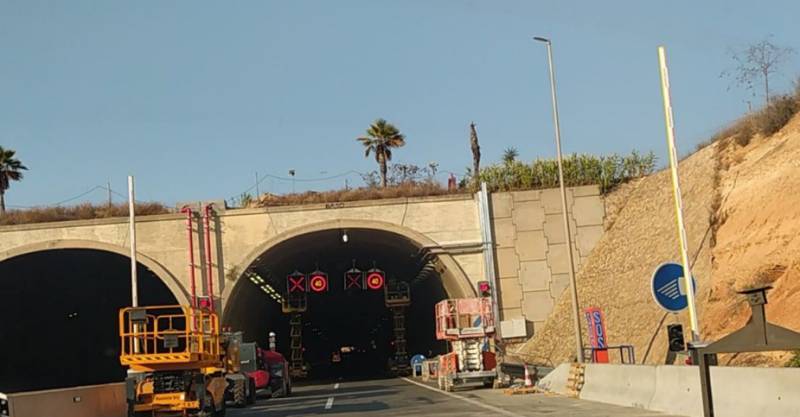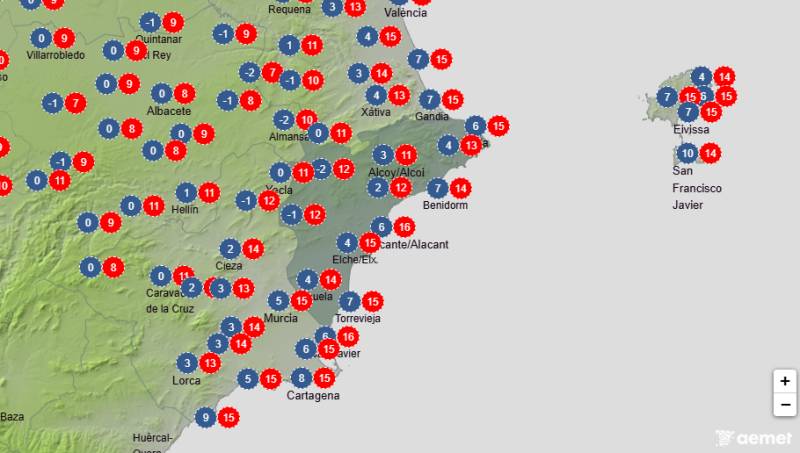- Region
- Vega baja
- Marina Alta
- Marina Baixa
- Alicante
- Baix Vinalopo
- Alto & Mitja Vinalopo
-
ALL TOWNS
- ALICANTE TOWNS
- Albatera
- Alfaz Del Pi
- Alicante City
- Alcoy
- Almoradi
- Benitatxell
- Bigastro
- Benferri
- Benidorm
- Calosa de Segura
- Calpe
- Catral
- Costa Blanca
- Cox
- Daya Vieja
- Denia
- Elche
- Elda
- Granja de Rocamora
- Guardamar del Segura
- Jacarilla
- Los Montesinos
- Orihuela
- Pedreguer
- Pilar de Horadada
- Playa Flamenca
- Quesada
- Rafal
- Redovan
- Rojales
- San Isidro
- Torrevieja
- Comunidad Valenciana
Santuario de la Virgen de Monserrate, Orihuela
The church of the Virgen of Monserrate
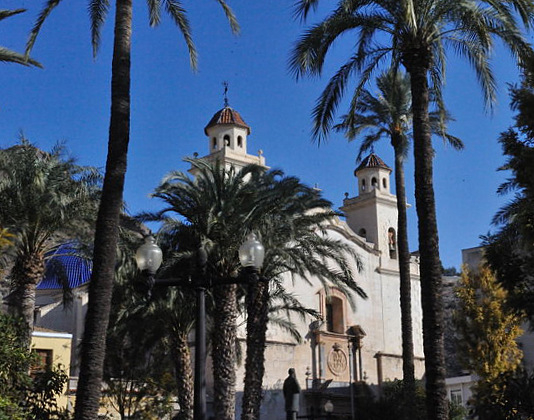 The sanctuary of the Virgin of Monserrate is located on the road into the old city centre from the north, in a square which bears the same name in the area known as Arrabal Roig or Rabaloche, and the first impression the visitor receives is one of simple but austere grandeur, projected by its imposing neo-classical façade featuring red and black marble on an otherwise plain stone front. Inset in the marble decoration is the mountain emblem of the church and its patron, featuring a large letter “M”.
The sanctuary of the Virgin of Monserrate is located on the road into the old city centre from the north, in a square which bears the same name in the area known as Arrabal Roig or Rabaloche, and the first impression the visitor receives is one of simple but austere grandeur, projected by its imposing neo-classical façade featuring red and black marble on an otherwise plain stone front. Inset in the marble decoration is the mountain emblem of the church and its patron, featuring a large letter “M”.
This church has a long history, spanning the era of Visigoth occupation through from the 6th to 8th centuries, and 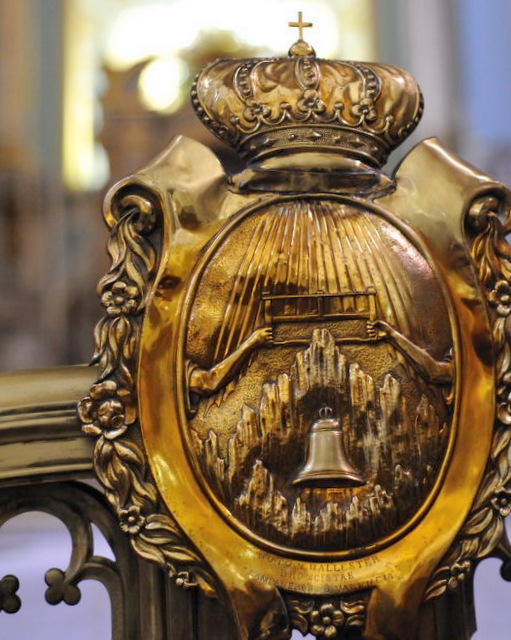 the subsequent era of Moorish occupation, before gaining importance following the Reconquist in the 13th century.
the subsequent era of Moorish occupation, before gaining importance following the Reconquist in the 13th century.
The story of this church begins in the year 792, when Visigoth Christians hid an image of the Virgin in a cave underneath the location of the bell which denoted their place of worship during a turbulent period when the Muslim invaders were clashing with the Christian Visigoths near to the end of a period of negotiated peace.
The Moors remained in power until 1243 when forces of the Christian Reconquist once again returned Christian rulers to power.
The church is said to have been founded after the simple Visigoth image of the Virgin Mary was found in about 1306 in the cave. Although there is no accurate representation of the original image, the 42cm high figure showed the seated Virgen, holding the baby Jesus in her left arm.  Although made only from olive wood, its value as a Christian relic was incalculable, but sadly, like so many other pieces of religious importance, it disappeared during the early days of the Civil War in the 1930s.
Although made only from olive wood, its value as a Christian relic was incalculable, but sadly, like so many other pieces of religious importance, it disappeared during the early days of the Civil War in the 1930s.
So many important religious sculptures were burnt or smashed just before the outbreak of Civil war, hundreds of churches fired and thousands of monks and nuns executed, Orihuela suffering the loss of many important artifacts, along with the rest of Spain.
The Virgin is reputed to have led her discoverers to the cave in which a modern replacement is shown today by means of tolling a bell, and the cave where she was found can still be seen at the foot of one of the side chapels. It occupies the same site as a previous chapel dedicated to San Julián, and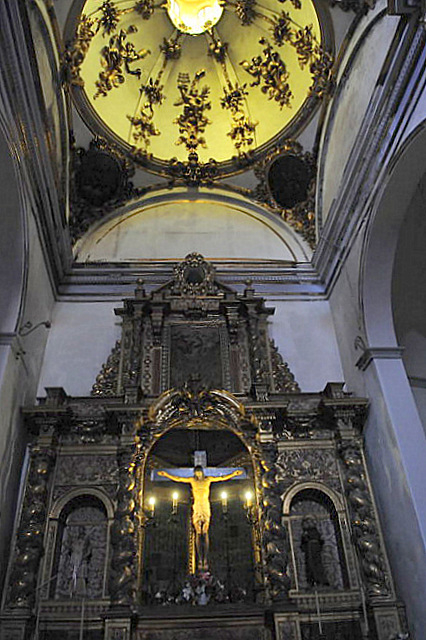 the side chapel of the “Hallazgo” (the discovery) also features the original altarpiece from the 17th century. The cave contains a replacement Virgen, made after the Civil War.
the side chapel of the “Hallazgo” (the discovery) also features the original altarpiece from the 17th century. The cave contains a replacement Virgen, made after the Civil War.
The “Hallazgo” chapel is presided over by a figure of Christ on the Cross, but this is not the original 18th century sculpture. Unfortunately this disappeared in August 1936, at the end of the Civil War, and a new Christ was not created and installed until 1940.
On either side of the figure of Christ are paintings of San Ramón and San Pascual, while at the top is an image of the coronation of the Virgin Mary in heaven, and at the bottom of the altarpiece on either side are images of the birth of Christ and the Adoration of the Magi. These images date from the 16th century.
An interesting little point for non-Catholics is the tradition relating to San Ramón, (Saint Raymond Nonnatus)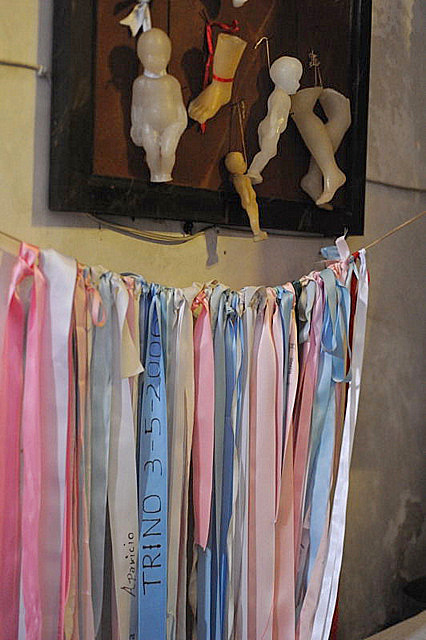 who is believed to protect mothers during childbirth. He himself was cut from the womb of his mother after she died giving birth.
who is believed to protect mothers during childbirth. He himself was cut from the womb of his mother after she died giving birth.
Pregnant parishioners write their name on a ribbon and take it to the church where it is hung on a rope joined to the saint via a pink ribbon tied around his waist. Some women leave the ribbon here for a period of days before tying it around their own waist for the duration of the pregnancy, others simply leave the ribbon in the church.
Ex votos, or wax figures are also left by the image of this saint if there is a sick child in the family or if an infant is born sickly, as a request for his intervention and protection.
This side chapel used to be the main altar, but the layout of the church was remodeled over 250 years ago: the current building dates mainly from the 18th century (the previous structure was largely destroyed by an earthquake in 1748), and the former main nave became the lateral axis of the cross-shaped distribution. Following the reconstruction of the church, the main image of the Virgen was moved to her current position in 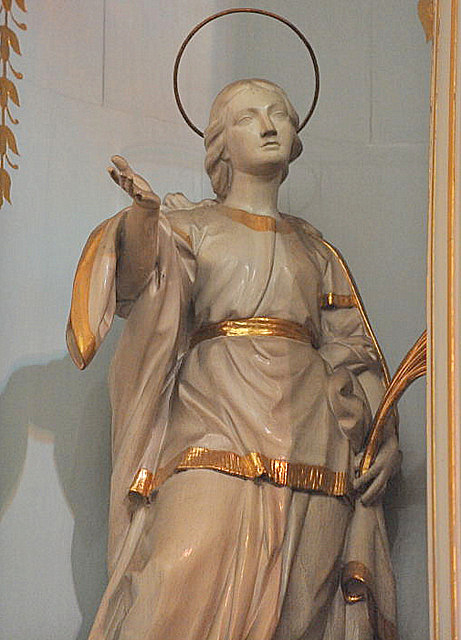 the main altarplace, although again this is a modern replacement by José María Sánchez Lozano. The niche in which the image of the Virgin is housed features especially elaborate gold-leaf decoration around it, including the mountain motif which constitutes the insignia of the Virgin of Monserrate herself.
the main altarplace, although again this is a modern replacement by José María Sánchez Lozano. The niche in which the image of the Virgin is housed features especially elaborate gold-leaf decoration around it, including the mountain motif which constitutes the insignia of the Virgin of Monserrate herself.
The dedication of this church to the Virgin of Monserrate stems back to the period when Orihuela was recaptured from the Moors in 1243, and in the following years the area was repopulated by immigrants from other parts of Spain. In the early 14th century, when the image of the Virgin was discovered, there were a large number of Catalans living in the town, and they wanted to name the apparition of the Virgin Monserrat, in remembrance of the patron saint of Catalunya. Other inhabitants from Valencia and Aragón wanted to use different names (Pilar and Orito, respectively), but lots were drawn and the Catalan option won the day.
However, this met with opposition from those who didn’t wish to replicate exactly the Catalan manifestation of  Mary, and the issue had to be resolved by the addition of an extra “e” in 1483 thanks to the intervention of no lesser authority than Pope Sixtus IV himself. Until this date the apparition of the Virgin had been known officially as the “Virgen de la Puerta”.
Mary, and the issue had to be resolved by the addition of an extra “e” in 1483 thanks to the intervention of no lesser authority than Pope Sixtus IV himself. Until this date the apparition of the Virgin had been known officially as the “Virgen de la Puerta”.
The nave is decorated with floral designs in painted wood and gold leaf, set off against the white stone which gives a sense of light to the Italian design of Bernardino Ripa. Another noteworthy feature are the images of 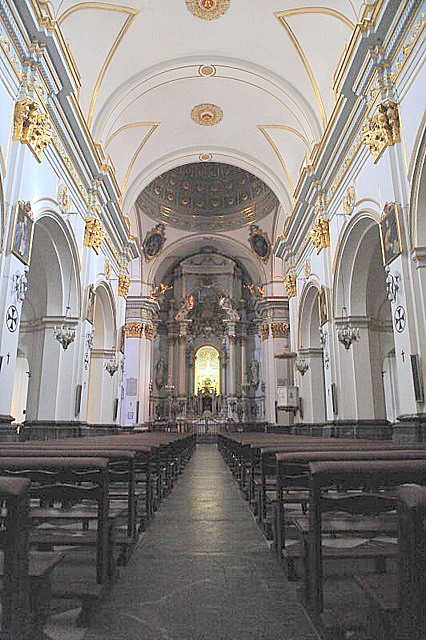 the saints Justa and Rufina, to whom one of the other important churches in Orihuela is dedicated, and who are also patron saints of Orihuela. Their images appear to be made of marble, but are in fact painted wood.
the saints Justa and Rufina, to whom one of the other important churches in Orihuela is dedicated, and who are also patron saints of Orihuela. Their images appear to be made of marble, but are in fact painted wood.
It is also possible to visit the sacristy, which was built at the end of the 17th century and survived the later earthquake, and which features magnificent stained glass windows and painted wooden sculptures with gold leaf decoration: if you can get the church attendant to open it for you, it’s well worth a look!
The organ was built by Juan Amezua in 1872, and forms part of Orihuela’s large catalogue of ornate and historic church instruments. Although neither the largest nor the oldest in the city, it is still an important part of the collection of which the city is so proud.
There are six chapels on either side of the main nave, each of them containing its own altar. Among the works of art in the building are paintings attributed to Antonio de Villanueva.
{image10}Also of note are the paintings of the apostles decorating the upper reaches of the main aisle: each portrait includes a piece of paper, on which one of the ten commandments are written.
The church can be visited from Tuesday to Friday between 10.00 and 14.00 in the morning and from 16.00 to 18.30 in the afternoon, except in August.
Location: Plaza de Monserrate
Click for map, Plaza de Monserrate
In June 2014, the church was awarded "Item of Cultural Interest status"















